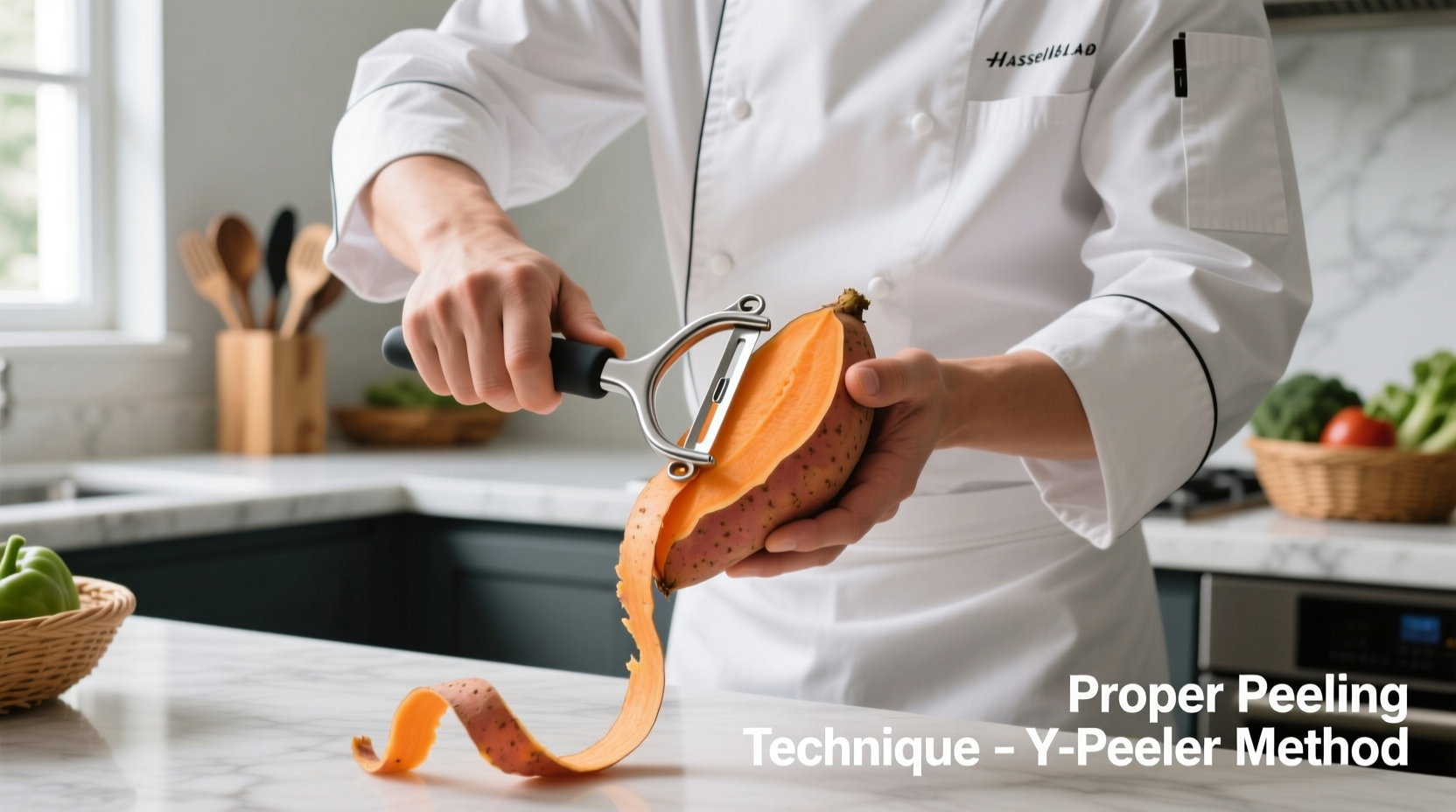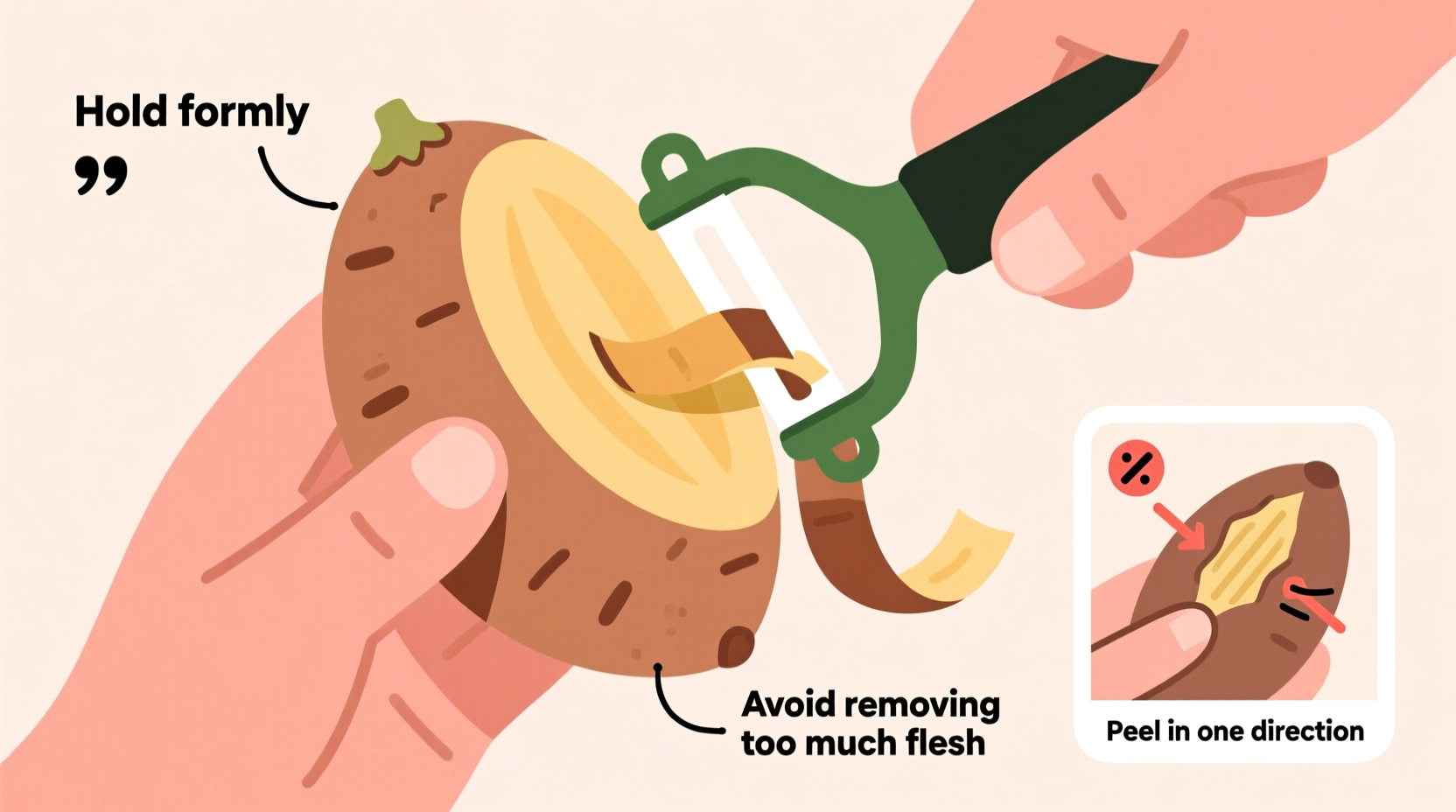Learning how to peel a sweet potatoes properly saves time, reduces waste, and prevents kitchen injuries. Whether you're preparing them for roasting, mashing, or baking, the right technique makes all the difference in your cooking experience. This guide reveals professional methods that home cooks can implement immediately.
Why Proper Sweet Potato Peeling Matters
Sweet potatoes have become a staple in modern kitchens thanks to their nutritional benefits and versatility. According to the USDA, one medium sweet potato provides over 400% of your daily vitamin A needs. However, their tough skin and irregular shape make peeling challenging compared to regular potatoes. Improper technique leads to excessive flesh removal (wasting up to 30% of the vegetable) or, worse, kitchen accidents.
| Peeling Method | Time Required | Flesh Preservation | Safety Level |
|---|---|---|---|
| Standard Vegetable Peeler | 3-4 minutes | Medium (15-20% waste) | High |
| Y-Shaped Peeler | 2-3 minutes | High (5-10% waste) | Very High |
| Knife Peeling | 4-5 minutes | Low (25-30% waste) | Moderate |
| Boiling & Slipping Skin | 15-20 minutes | Very High (minimal waste) | High |
Essential Tools for Peeling Sweet Potatoes
Before you start, gather these kitchen essentials:
- Y-shaped vegetable peeler - Provides better grip and control for tough skins
- Sharp paring knife - For stubborn spots or alternative peeling method
- Cutting board - Preferably with non-slip base
- Bowl of cold water - To prevent browning after peeling
- Hand towel - For secure grip on wet potatoes
Professional chefs consistently recommend Y-shaped peelers over straight models for sweet potatoes. The American Culinary Federation notes that the ergonomic design reduces hand fatigue during extended prep work and provides better angle control for navigating the vegetable's curves.
Step-by-Step: Raw Sweet Potato Peeling Method
This technique works best when you need raw sweet potato pieces for recipes:
- Chill the sweet potatoes in refrigerator for 10-15 minutes - cold firmness makes peeling easier
- Wash thoroughly under running water to remove dirt from crevices
- Dry completely with a clean towel to ensure secure grip
- Hold the potato firmly in your non-dominant hand, placing your thumb at the top
- Position peeler at 45-degree angle against the skin, starting from the top
- Use firm downward strokes following the potato's natural shape
- Rotate the potato as you work, maintaining consistent pressure
- Transfer peeled potatoes immediately to cold water to prevent oxidation

Alternative Method: Peeling Cooked Sweet Potatoes
When recipes call for cooked sweet potatoes (like for mashing), this method preserves more nutrients:
- Boil or steam sweet potatoes until just tender (15-20 minutes)
- Cool for 5-7 minutes until handleable but still warm
- Make a shallow slit lengthwise with a knife
- Gently squeeze from both ends to loosen skin
- Peel skin away using fingers or knife tip - it should slip off easily
- Work quickly before potatoes cool completely and skin re-adheres
This technique works because heat causes the skin to separate from the flesh. The FDA Food Code recommends this method for maximum nutrient retention, as boiling whole sweet potatoes preserves more water-soluble vitamins than cutting before cooking.
Safety Considerations and Common Mistakes
Sweet potatoes cause more kitchen cuts than many realize due to their firm texture and irregular shape. Follow these safety guidelines:
- Avoid peeling extremely small pieces - use a knife to cut larger sections first
- Never peel toward your body - always work away from yourself
- Replace dull peelers immediately - they require more force and slip easily
- Don't attempt to peel completely round potatoes - cut flat surface first
- Stop if you feel hand fatigue - tired hands lead to loss of control
Context matters significantly when peeling sweet potatoes. The University of California Cooperative Extension notes that sweet potato varieties differ substantially in skin thickness - Japanese sweet potatoes have thinner skins than Garnet varieties, requiring less pressure during peeling. Additionally, sweet potatoes harvested in autumn have thicker skins than summer crops, affecting your technique.
Troubleshooting Peeling Problems
Encountering these common issues? Here's how to fix them:
- Peeler keeps slipping: Dry the potato thoroughly and chill it for 5 more minutes
- Removing too much flesh: Use lighter pressure and maintain consistent 45-degree angle
- Stubborn spots won't peel: Switch to paring knife for targeted removal
- Hands becoming slippery: Keep dry towel nearby to maintain grip
- Sweet potato browning: Submerge in water with tablespoon of lemon juice
Storing Peeled Sweet Potatoes Properly
Proper storage prevents waste and maintains quality:
- Submerge in cold water with acid (1 tbsp lemon juice per quart)
- Store in airtight container in refrigerator
- Use within 24 hours for best quality
- Don't freeze uncooked peeled sweet potatoes - texture deteriorates
Food safety experts at the National Center for Home Food Preservation emphasize that peeled sweet potatoes left at room temperature for more than two hours enter the danger zone for bacterial growth. Always refrigerate immediately after peeling if not using right away.
When NOT to Peel Sweet Potatoes
Sometimes leaving the skin on provides benefits:
- When roasting whole sweet potatoes
- For maximum fiber content (skin contains 3g fiber per potato)
- When making sweet potato fries (skin adds texture)
- If using organic sweet potatoes with clean skins
The Academy of Nutrition and Dietetics recommends keeping skins on when possible, as they contain significant amounts of fiber and antioxidants. Just ensure thorough washing with a vegetable brush before cooking with skins intact.
What's the easiest way to peel sweet potatoes without wasting flesh?
The most efficient method is using a Y-shaped peeler on chilled sweet potatoes at a 45-degree angle with firm, downward strokes. Chilling firms the flesh, allowing thinner peeling that preserves up to 90% of the vegetable compared to knife methods that waste 25-30%.
Can I peel sweet potatoes after cooking them?
Yes, peeling cooked sweet potatoes is often easier. Boil or steam until just tender (15-20 minutes), cool for 5-7 minutes, make a shallow slit, then gently squeeze from both ends. The skin should slip off easily while preserving nearly all the flesh.
Why are my sweet potatoes so difficult to peel?
Sweet potatoes become harder to peel when too fresh or at room temperature. Chill them for 10-15 minutes before peeling to firm the flesh. Older sweet potatoes with thicker skins (common in winter varieties) also require more pressure. Using a dull peeler or incorrect angle contributes to difficulty.
Should I peel sweet potatoes before boiling them?
No, it's better to boil sweet potatoes with skins on to preserve nutrients and prevent water absorption. The FDA Food Code recommends cooking whole when possible, as boiling peeled sweet potatoes causes up to 30% more nutrient loss. Peel after cooking when the skin slips off easily.
How do I prevent cut sweet potatoes from turning brown?
Immediately submerge peeled sweet potatoes in cold water with one tablespoon of lemon juice or vinegar per quart. The acid prevents oxidation. Store in this solution in an airtight container in the refrigerator for up to 24 hours before use.











 浙公网安备
33010002000092号
浙公网安备
33010002000092号 浙B2-20120091-4
浙B2-20120091-4